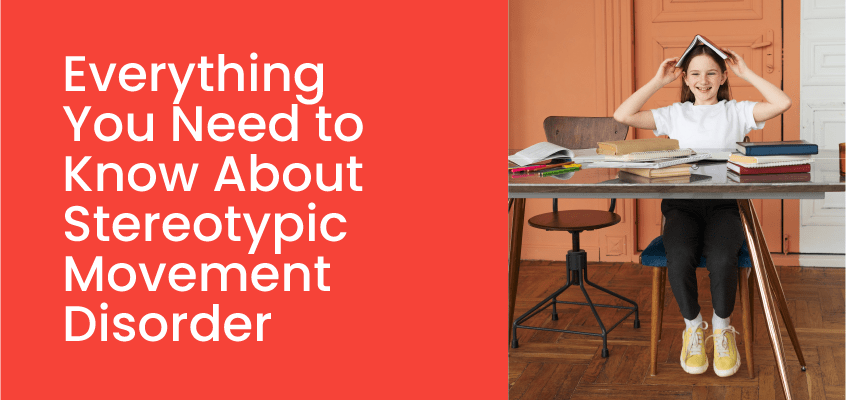Introduction
Stereotypic movement disorder mainly occurs during childhood; children with this disorder make repeated, sometimes rhythmic, random and unnecessary movements. The symptoms usually surface during the first three years of life. However, random motions are typical at that age and should not be confused with this disorder. This article explains stereotypic movement disorder and its causes, diagnosis, and treatment.
What is stereotypic movement disorder?
This disorder involves uncommon and unnecessary movements that are repetitive or rhythmic. These movements are called stereotypies and include simple motions like nail biting, finger wiggling, and rocking back and forth; they could also have jerky, hurtful actions like hitting the head or picking at the skin.
If your child has stereotypic movement disorder[1], you should pay close attention to their stereotypes. These will often be predictable and repetitive patterns of one or a combination of movements. Also, these motions become frequent and aggressive when your child feels excited, frustrated, stressed, or upset.
In some cases, the symptoms of stereotypic movement disorder go away with time, while they continue to adulthood in other cases. The best action is to monitor your child’s symptoms and speak with their paediatrician. Get help from a child psychologist if their symptoms continue, and they begin to act aggressively or hurt themselves or others.
Symptoms of stereotypic movement disorder
The symptoms of stereotypic movement disorder[2] involve common and uncommon movements. These stereotypies’ rhythmic and predictable nature is a telltale sign of this condition. Doctors divide its symptoms into simple and complex stereotypes based on severity.
Simple stereotypies include:
-
Shaking hands
-
Waving hands
-
Rocking back and forth
-
Wiggling fingers
-
Sucking thumbs
-
Biting nails
-
Nodding head back and forth or sideways
-
Twisting hair
-
Thumb sucking
Complex stereotypies include:
-
Banging head
-
Picking at the skin
-
Hitting someone
-
Mouthing objects
-
Biting themselves
Adults with this disorder have a slightly distinct set of stereotypes, such as:
-
Tapping hands
-
Shaking legs
-
Fidgeting
-
Touching the face
In many cases, specific symptoms like waving hands co-occur with both hands. Overwhelming emotions such as anger, excitement, sadness, and stress are known to increase the severity and frequency of the symptoms of stereotypic movement disorder.
Diagnosis of stereotypic movement disorder
Diagnosing a stereotypic movement disorder begins with the doctor checking your child’s medical history. They might also ask you about the family’s medical history and if anyone has had this condition. While there is no particular test for the diagnosis of stereotypic movement disorder, there are a few parameters:
A person is said to have this disorder only if:
-
They display two or more stereotypies (characteristic movements).
-
The symptoms persist for over four weeks, and the stereotypes interfere with their daily activities.
The doctor rules out other possibilities if your child meets all these parameters. They may prescribe some tests as well as scans for neurological imaging. Based on their findings, the doctor prescribes a treatment option.
What causes stereotypic movement disorder?
The exact cause of stereotypic movement disorder is as yet unclear. However, certain factors and conditions might contribute to the development of this disorder. It also indirectly relates to the imbalances in the part of the brain that controls movement, which could occur due to congenital conditions or injuries.
The potential contributing factors are:
-
Use of stimulant drugs like cocaine and amphetamine
-
Long-term abuse of stimulatory drugs
-
Chorea disease
-
Autism spectrum disorder (A.S.D.)
-
Obsessive-compulsive disorder (O.C.D.)
-
Tourette’s syndrome or tics disorder
-
Intellectual disabilities
-
Developmental disabilities
-
Impaired vision or hearing
Genetics could also predispose your child to stereotypic movement disorder. In addition, boys are at a higher risk of having this disorder.
Treatment of stereotypic movement disorder
As the exact cause of stereotypic movement disorder is still a matter of research, there is no fixed treatment currently[3]. Stereotypic movement disorder is often misdiagnosed as tics or Tourette syndrome (T.S.). The treatment generally involves taking care of any injuries resulting from the stereotypes and preventing them in the future. Other therapeutic and medicinal approaches may also help.
Therapy-based treatment methods include:
-
Functional communication training (F.T.C.): This therapy involves training your child to perform alternative motions whenever they sense the urge to perform stereotypic movements. It should distract them from indulging in stereotypes.
-
Differential reinforcement of other behaviour (D.R.O.): This method reduces the chances of injury due to stereotypes. For instance, if your child has a stereotype of picking at their skin, you can make them wear gloves or full-sleeved shirts. The D.R.O. method involves altering your child’s surroundings to discourage stereotypies and prevent injuries.
Medication-based treatment for stereotypic movement disorder involves antidepressants such as selective serotonin reuptake inhibitors (SSRIs) and tricyclic antidepressants.
You can also teach your child relaxation techniques like deep breathing to distract them from stereotypes. Teach them to perform these exercises whenever they feel overwhelmed. If you’re looking for mental health care in the comfort of your home, visit United We Care, an online mental health platform with expert child psychologists who can help you improve your child’s life. Click here to contact a child psychologist today!
Conclusion
Stereotypic movement disorder is more common among children and goes away with time. Complex forms of this disorder that continue into adulthood are sporadic. However, if you notice persistent and aggressive symptoms in your child, getting them the appropriate treatment would prevent them from getting more severe. Along with the therapies and medicinal treatment, teaching your kids relaxation techniques would help control their stereotypies. Providing constant emotional support to your child during this period is also necessary.
References
[1] https://www.sciencedirect.com/science/article/abs/pii/S1071909117301535
[2] https://medlineplus.gov/ency/article/001548.htm
[3] https://www.mentalhelp.net/disorders-of-childhood/treatment-of-stereotyped-movement-disorders/











